This article was co-authored by Chris M. Matsko, MD. Dr. Chris M. Matsko is a retired physician based in Pittsburgh, Pennsylvania. With over 25 years of medical research experience, Dr. Matsko was awarded the Pittsburgh Cornell University Leadership Award for Excellence. He holds a BS in Nutritional Science from Cornell University and an MD from the Temple University School of Medicine in 2007. Dr. Matsko earned a Research Writing Certification from the American Medical Writers Association (AMWA) in 2016 and a Medical Writing & Editing Certification from the University of Chicago in 2017.
There are 13 references cited in this article, which can be found at the bottom of the page.
This article has been viewed 193,391 times.
Jock itch is most commonly a ringworm (not actually a worm but fungal organisms called dermatophytes) infection known in the medical field as tinea cruris; however, the symptoms may also appear due to a bacterial infection (such as staphylococcus). Jock itch typically affects the groin, inner thighs, or buttocks, because this area is usually moist and tightly covered by clothing, and most commonly affects adult and middle-aged men . Damp skin is the perfect breeding environment for fungus and bacteria. Luckily, you can treat most cases of jock itch at home with over-the-counter treatments, and you can also visit your doctor for a prescription-strength medication for moderate-to-severe cases lasting longer than two weeks.
Steps
Treating Jock Itch at Home
-
1Identify the symptoms of jock itch. The groin, inner thighs, and buttocks are the most common areas affected by jock itch since the region is prone to dampness which help the responsible bacteria and fungi to spread. While you can treat most cases of jock itch at home, you should still see your doctor for an official diagnosis, as well as testing to determine the cause (whether a fungus or bacteria) since this can alter the treatment method. The symptoms of jock itch usually include:[1]
- Itching, redness, or scaling of the skin in ring or half-moon shapes
- Burning sensations
- Pain (usually bacterial infection)
- Blistering along the edge of the rash
-
2Wash the groin skin two to three times a day with an antifungal shampoo. Keeping the area clean will help stop the spread of the fungus or bacteria causing the symptoms. Wash the skin two to three times a day using an antifungal shampoo for the duration of your treatment.
- You can buy these shampoos without a prescription, and some options include ketoconazole (Nizoral)[2] or selenium sulfide (Selsun Blue).[3] Many of these shampoos are marketed for use against dandruff. However, skin fungus is a common cause of dandruff, and these shampoos do have antifungal formulations.[4]
Advertisement -
3Keep the area dry. Excess moisture forms a breeding ground for the bacteria and fungi that can cause jock itch. Dry your groin completely after each time you wash the area, and make sure you dry any excess sweat in the area throughout the day as well.[5] Change out of gym clothes immediately and wash them between uses to help prevent jock itch.
- Looser-fitting cotton underwear will help reduce excess sweating, and it will also allow sweat to dry faster.
- Change your towel every day while treating your jock itch, and do not share towels with anyone.
- You can use a powder like Gold Bond to keep the area dry.
-
4Spread an antifungal cream over the area. Several over-the-counter, antifungal creams are available to help you treat jock itch. Apply after each time you wash and dry the area, and make sure you spread the cream past the edges of the rash.[6]
- Choose options that include terbinafine, miconazole, or clotrimazole. Brands with these as the active ingredients include Lamisil, Lotrimin, Micatin, and Monistat.[7] Always follow the directions on the packaging for your specific product, and contact your doctor if the symptoms don’t improve after two weeks.
- You can also apply a layer of zinc oxide ointment over the other products. This will help protect the skin from additional irritation and wetness.[8]
- Make sure to thoroughly wash your hands after each application or any other time you come in contact with the region.
-
5Avoid harsh chemicals on the area. Harsh laundry detergents, bleach, and even fabric softeners in your laundry can lead to additional irritation that can exacerbate your jock itch. Try to avoid these and any other harsh chemicals that can come into contact with your groin for the entire course of your treatment.
-
6Use an aluminum salt solution. Aluminum salt solutions, such as aluminum chloride 10% soIution or aluminium acetate, are effective antiperspirants because they form plugs on the sweat glands. To use this mixture:[9]
- Mix one part aluminum salt with 20 parts water. Apply this solution to the infected area and leave it on for six to eight hours. It is best to apply it at night because that is when your sweat glands are least active. Wash the solution off when you think you will start sweating again. Repeat this process until the lesions become dry and start to fade.
-
7Use medicated compresses for any blisters. The fungal ringworm responsible for most cases of jock itch can occasionally cause large area of skin to blister. You can still treat these at home with medicated compresses, such as using a Burow’s Solution. This will dry out the blisters and soothe any discomfort, which will allow you to then resume treatment with the antifungal creams.
-
8Treat athlete’s foot. If your jock itch occurs concurrently with athlete’s foot, then you can easily spread the fungi back to your groin when putting your feet through your underwear to put them on. Make sure to treat both conditions to avoid reinfecting your groin.[10]
-
9Try holistic options. If you’d prefer to use a home remedy option, then you have a few different options available. You can:
- Dip gauze or a washcloth in diluted white vinegar (one part vinegar to four parts water). Hold it against the infection twice a day. Once you remove the cloth, pat the skin dry but do not rub it too hard or the infection could scab over.
- Pour 1/4 cup of bleach (such as Clorox) into a bathtub full of water and soak in it daily or every other day for minor cases. Ensure that you thoroughly dry the skin when you get out.
- Apply a 0.6% ajoene gel. This extract comes from garlic and contains a natural antifungal compound. You can apply it twice daily for up to two weeks.[11]
Seeing Your Doctor for Treatment
-
1See your doctor if the condition doesn’t improve in two weeks. If the condition doesn’t improve within two weeks of home treatments, then you either require a prescription-strength antifungal option, or it may be possible that your jock itch is bacterial instead of fungal. Your doctor will also be able to prescribe antibiotics if this is the case.
- Your doctor will likely swab the affected area and send the swab to a lab for a culture. This skin culture will help your doctor determine whether the jock itch is indeed fungal or caused by bacteria (commonly staphylococcus).[12]
-
2Discuss prescription antifungal creams. If your doctor determines that the condition is fungal, but over-the-counter treatments didn’t work for two (or more) weeks, then your doctor will likely recommend a prescription-strength antifungal cream. These options include:[13] [14]
- Oxiconazole 1% (Oxistat)
- Econazole 1% (Spectazole)
- Sulconazole 1% (Exelderm)
- Ciclopirox 0.77% (Loprox)
- Naftifine 2% cream
- Note that econazole, sulconazole, ciclopirox, and naftifine cannot be used in children. The side effect of these drugs include burning sensation, skin irritation, stinging, and redness.
-
3Ask about oral antifungal medications. If your case of jock itch has been recurrent or if you are immunosuppressed (such as those with HIV), then your doctor may suggest stronger, oral antifungal drugs. These options may include:[15]
- Griseofulvin 250 mg twice daily until cure is reached
- Terbinafine 250 mg/day for 2-4 weeks
- Itraconazole 200 mg/day for 1 week
- Fluconazole 150 - 300 mg/week for 2-4 weeks
- Ketoconazole 200 mg/day for 4-8 weeks
- Note that these medications cannot be used in children or in pregnant women. The common side effects of these drugs include liver damage, dizziness, seizures, nausea, and vomiting. When prescribed, physicians generally monitor the patient's liver functioning periodically.
-
4Discuss topical antibiotic options. If the culture confirms that your condition is actually the result of a bacterial skin infection, then your doctor will discuss antibacterial creams to apply to the area. These options may include:
- Erythromycin applied twice daily
- Clindamycin applied twice daily
- Metronidazole applied twice daily
- Your doctor may also recommend that you use an antibacterial soap to wash the skin before applying these. OTC antibacterial soaps include Lever 2000 or a chlorhexidine soap such as Hibiclens.
-
5Inquire about oral antibiotic options. For more-severe cases of bacterial jock itch, your doctor will prescribe a course of oral antibiotics. Depending on the drug, the prescription could be for anywhere between 5 and 14 days. Some of these antibiotics include:
- Cephalexin (Keflex)
- Dicloxacillin
- Doxycycline
- Minocycline (Dynacin or Minocin)
- Erythromycin
Expert Q&A
Did you know you can get expert answers for this article?
Unlock expert answers by supporting wikiHow
-
QuestionHow can I treat severe jock itch at home?
 Chris M. Matsko, MDDr. Chris M. Matsko is a retired physician based in Pittsburgh, Pennsylvania. With over 25 years of medical research experience, Dr. Matsko was awarded the Pittsburgh Cornell University Leadership Award for Excellence. He holds a BS in Nutritional Science from Cornell University and an MD from the Temple University School of Medicine in 2007. Dr. Matsko earned a Research Writing Certification from the American Medical Writers Association (AMWA) in 2016 and a Medical Writing & Editing Certification from the University of Chicago in 2017.
Chris M. Matsko, MDDr. Chris M. Matsko is a retired physician based in Pittsburgh, Pennsylvania. With over 25 years of medical research experience, Dr. Matsko was awarded the Pittsburgh Cornell University Leadership Award for Excellence. He holds a BS in Nutritional Science from Cornell University and an MD from the Temple University School of Medicine in 2007. Dr. Matsko earned a Research Writing Certification from the American Medical Writers Association (AMWA) in 2016 and a Medical Writing & Editing Certification from the University of Chicago in 2017.
Family Medicine Physician
References
- ↑ https://my.clevelandclinic.org/health/diseases/22141-jock-itch-tinea-cruris
- ↑ https://www.drugs.com/mtm/ketoconazole-topical.html
- ↑ https://my.clevelandclinic.org/health/articles/4560-athletes-foot-jock-itch-and-ringworm-of-the-scalp
- ↑ https://columbiaskinclinic.com/medical-dermatology/6-causes-of-dandruff-and-how-to-treat-them/
- ↑ https://www.health.harvard.edu/a_to_z/jock-itch-tinea-cruris-a-to-z
- ↑ https://my.clevelandclinic.org/health/diseases/22141-jock-itch-tinea-cruris
- ↑ http://www.nlm.nih.gov/medlineplus/ency/article/000876.htm
- ↑ http://www.mayoclinic.org/drugs-supplements/zinc-oxide-topical-application-route/description/drg-20075525
- ↑ https://www.ncbi.nlm.nih.gov/pmc/articles/PMC4740689/
- ↑ https://www.aad.org/public/diseases/a-z/athletes-foot-prevent
- ↑ http://www.ncbi.nlm.nih.gov/pubmed/10417874
- ↑ http://www.nlm.nih.gov/medlineplus/ency/article/000876.htm
- ↑ Andrews MD, Burns M. Common tinea infections in children. Am Fam Physician. 2008;77(10):1415-1420.
- ↑ Kelly BP. Superficial fungal infections. Pediatr Rev. 2012;33(4):e22-37.
- ↑ Gupta AK, Chaudhry M, Elewski B. Tinea corporis, tinea cruris, tinea nigra, and piedra. Dermatol Clin. 2003;21(3):395-400.
- ↑ Gupta AK, Chaudhry M, Elewski B. Tinea corporis, tinea cruris, tinea nigra, and piedra. Dermatol Clin. 2003;21(3):395-400.
About This Article
To treat jock itch, try washing the affected area twice a day with an anti-dandruff shampoo, like Nizoral or Selsun Blue, to stop the spread of the fungus or bacteria. Each time after you wash the area, spread an anti fungal cream on the affected skin. Then, keep the area dry by wearing loose-fitting cotton underwear. Alternatively, you can try soaking a washcloth in diluted vinegar and holding it against the infected skin twice a day until the rash is gone. For tips from our Medical reviewer on how to know when you should see a doctor about your jock itch, keep reading.
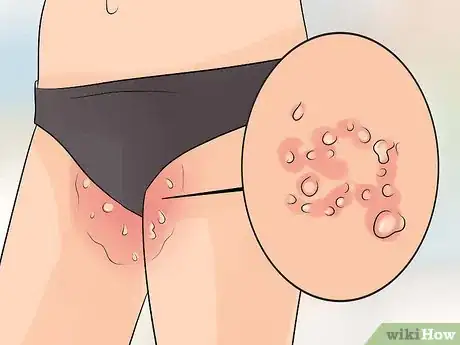
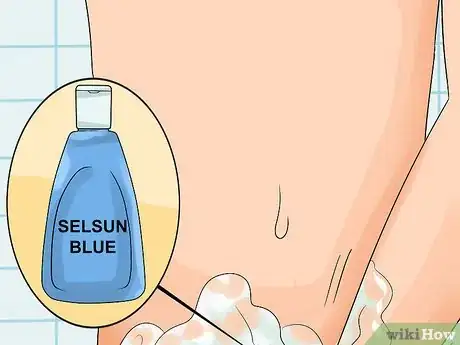
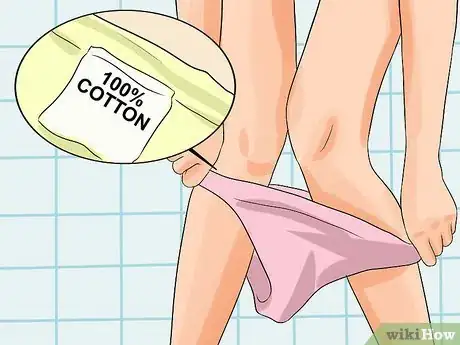
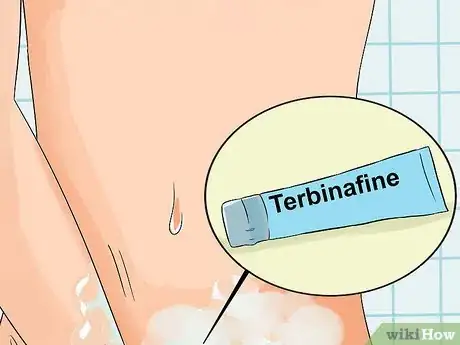
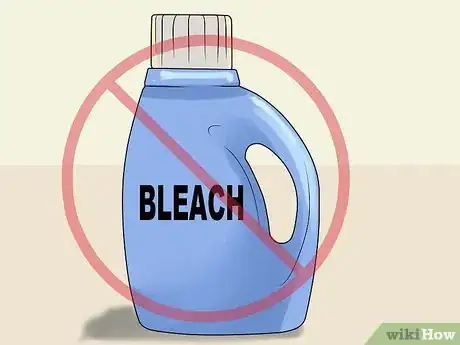
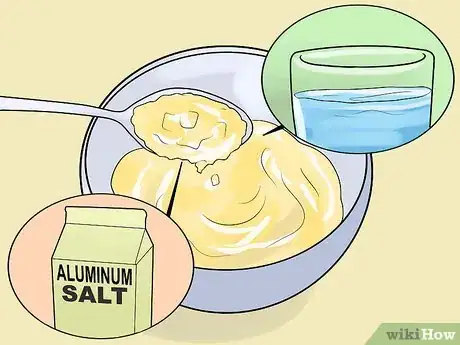
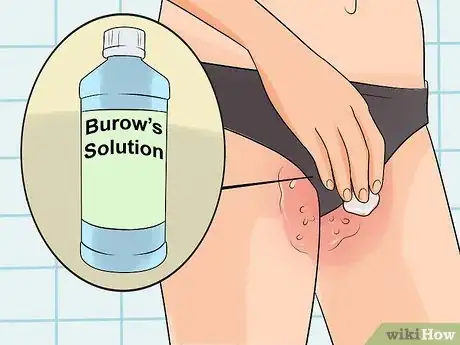
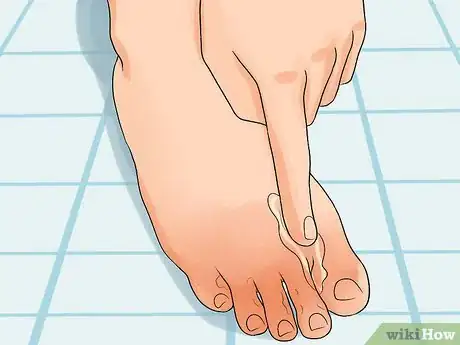
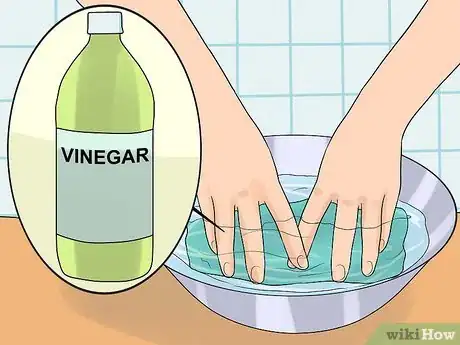
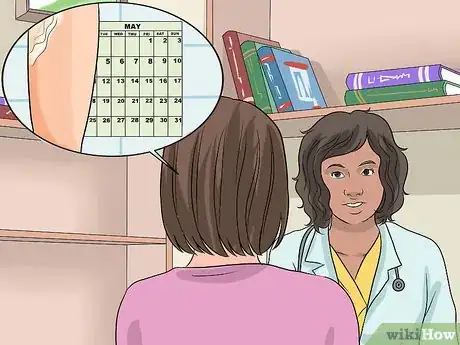
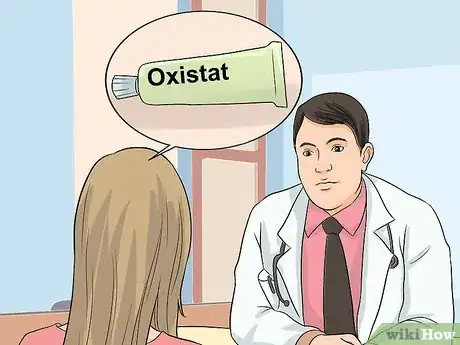
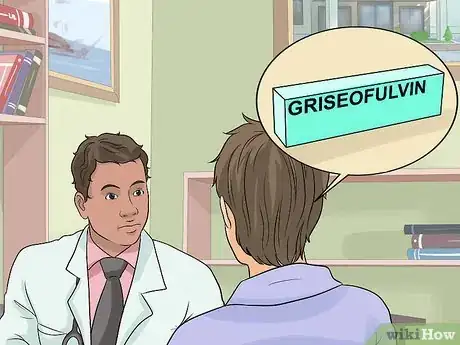
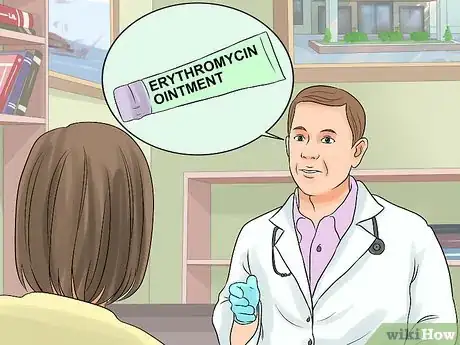
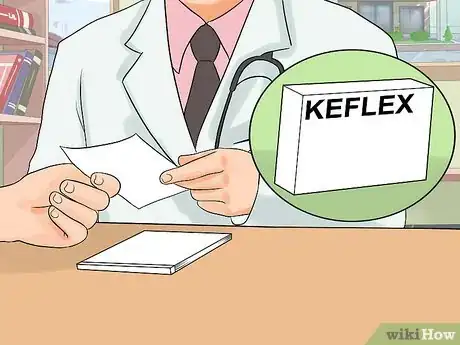
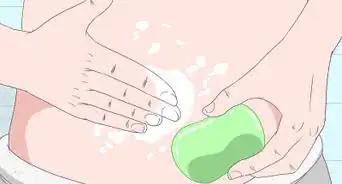
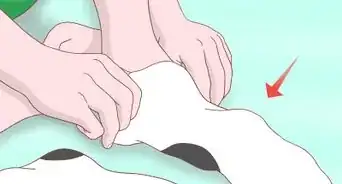
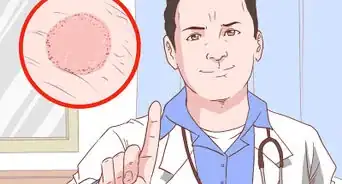
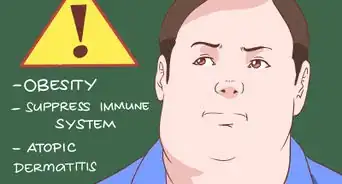
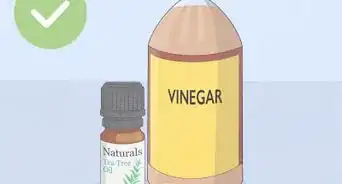


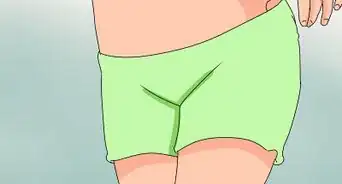
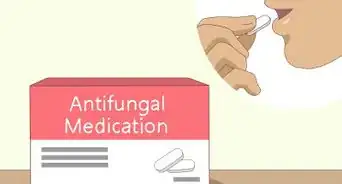
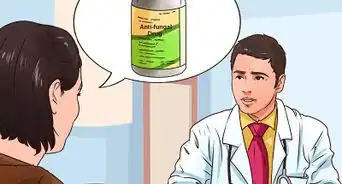
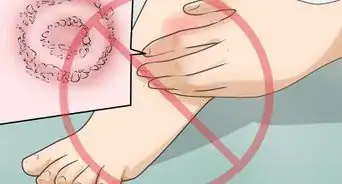
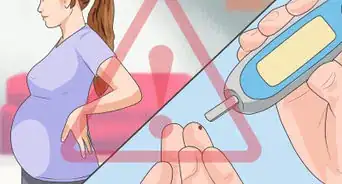
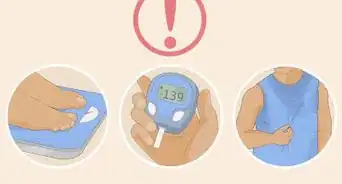
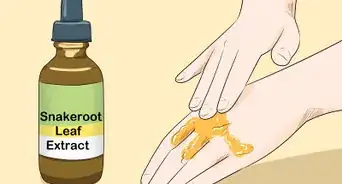







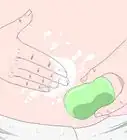
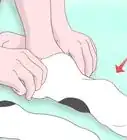
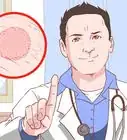




































Medical Disclaimer
The content of this article is not intended to be a substitute for professional medical advice, examination, diagnosis, or treatment. You should always contact your doctor or other qualified healthcare professional before starting, changing, or stopping any kind of health treatment.
Read More...